The straight path that links Windsor Castle with Snow Hill in Windsor Great Park is known as The Long Walk.

How long is the long walk in Windsor?
From the Castle gate to the foot of the statue of King George III (The Copper Horse) The long walk measures 2.64 miles in length. So a run there and back is a great distance for joggers and is a very popular route for walkers too.
Snow Hill, as the legend has it, was where King Henry VIII sat and waited for news of the execution of his second wife, Queen Anne Boleyn. However, the path as we know it only came into being during the reign of King Charles II who had double rows of Elm trees planted the entire length of the route. There were 1,652 trees planted to create the basis of the landscape we know today. Charles had previously spent time at Versailles and wanted to remodel Windsor in a similar flamboyant style. The Long Walk was just one aspect of his improvement plans.
Later in 1710 Queen Anne had a road constructed down the centre of the tree lined avenue so that coaches could head out into the park on a comfortably smooth surface. A little way down from the Castle, the Long Walk is crossed by the Albert Road (A308) to old Windsor. Cars often slow to a walking pace to enjoy the views in both directions.
How long does it take to walk the Long Walk?
Since the average walking pace is around 20 minutes per mile, you could go from the castle end to snow hill in 45 minutes, but of course then you would have to turn around and walk back. So to complete the long walk you should allow yourselves at least an hour and a half. However, once you have walked to snow hill there is a nice little cheat worth knowing. You can head left along the path that crosses the end of the walk and make your way to the fox and hounds pub for a bit of halfway refreshment or even order a cab to pick you up and drive you back into town.
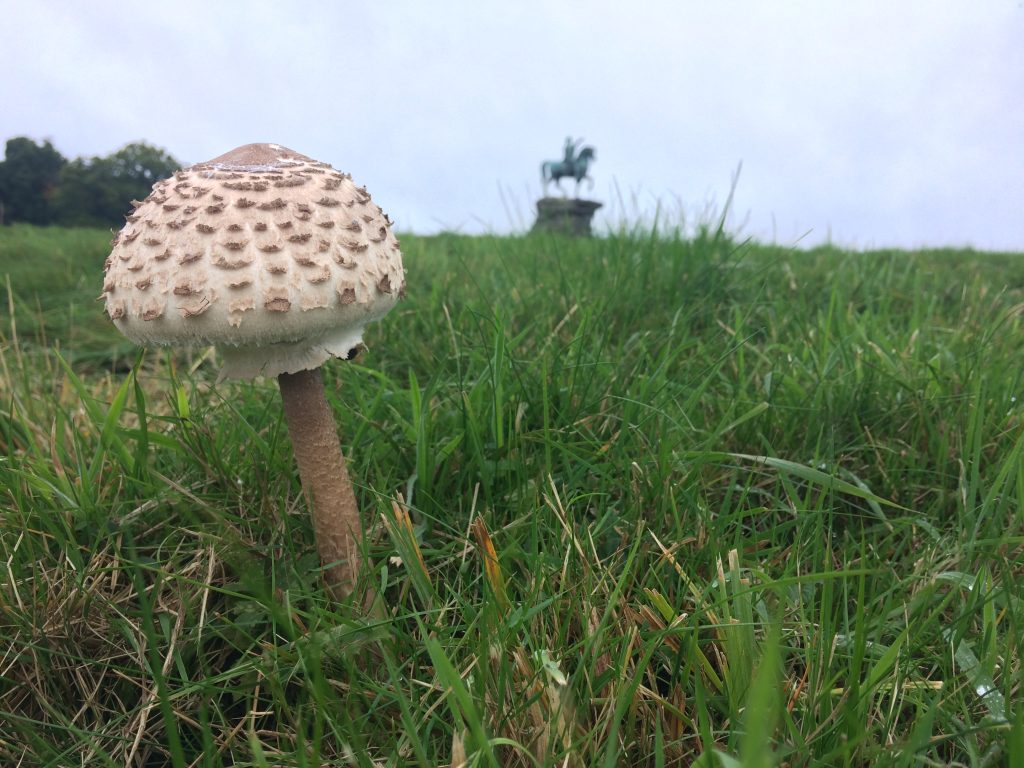
The Copper Horse statue is a huge installation and worth visiting in its own right. The view back toward the Castle is spectacular and you can see the Staines reservoirs, Harrow on the Hill, Wembley Stadium , Heathrow and the skyscrapers of London from this great vantage point. In summer this is a popular picnic spot.
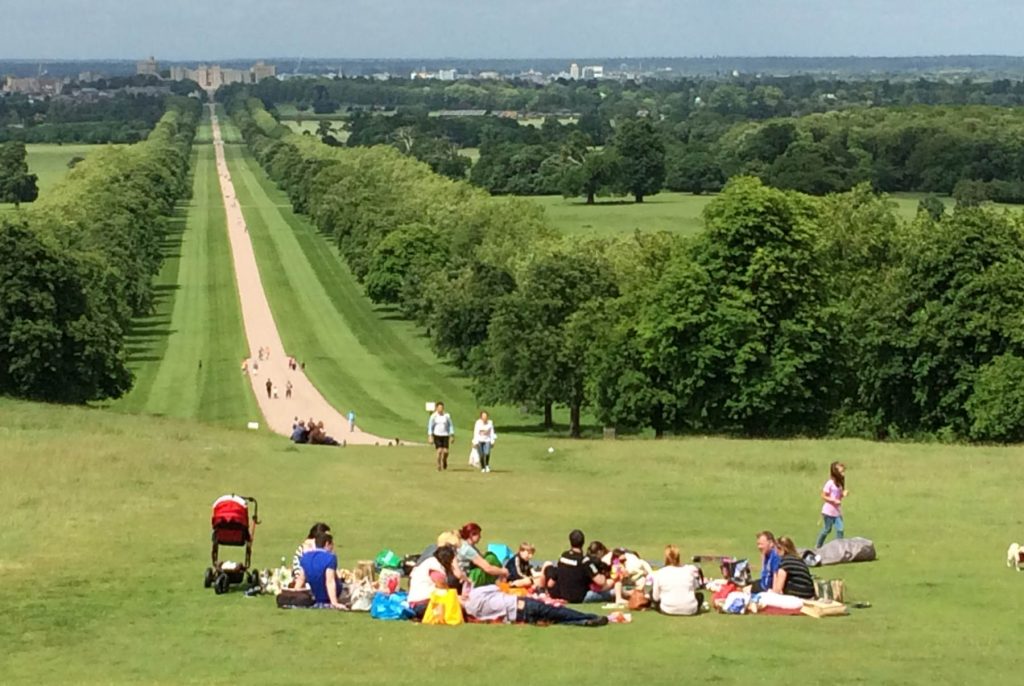
The Long Walk is still used by the royal carriages every year as part of the route from Windsor Castle to the Ascot Races. Occasionally a warden’s car comes down Windsor’s Long Walk but other than that it is free from all except pedestrian traffic. Cycling is not permitted on any part of the Long Walk.
Over the years Elms have been replaced by Oak, Horse Chestnut and London Plane trees. At the Park Street (Castle) end of the Long Walk Horse Chestnuts predominate, although these trees, which have provided conkers for generations of Windsor schoolboys succumbed to the bacterial canker outbreak of 2008 which meant the leaves went brown and dropped very early on. Although in 2009, the canker was still apparent, the trees looked much less affected and there were hopes of a reprieve. However, the following year they once again suffered. 2011 was dry and the blight was not so serious but there was still evidence of the disease. In the following few years the trees have not seen a marked deterioration and twelve years later they are still standing proudly.
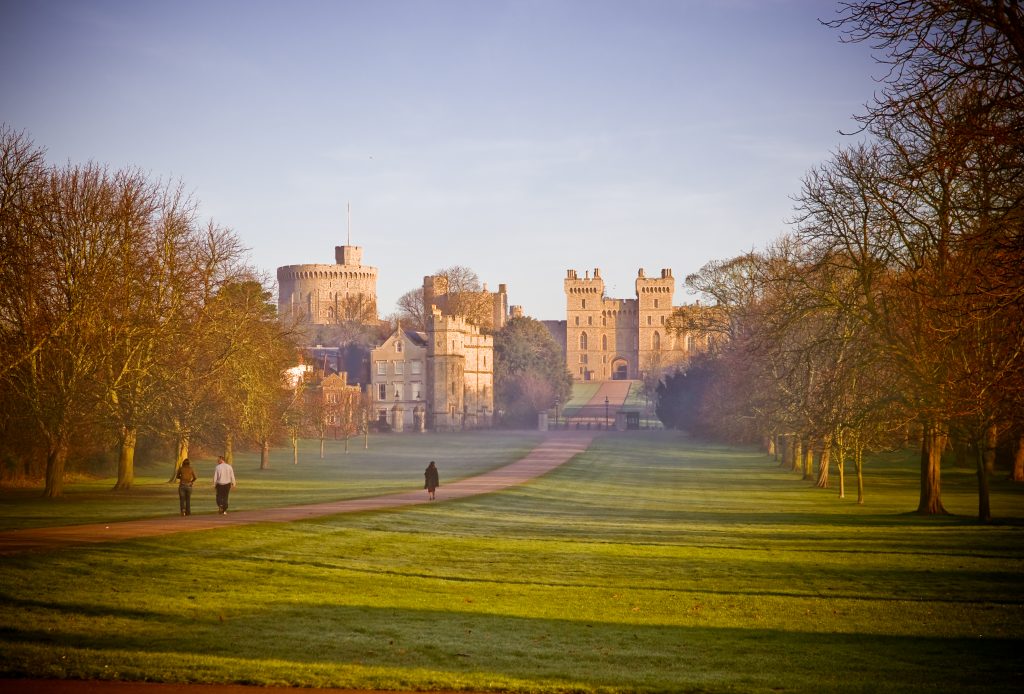
Alongside the tens of thousands of visitors, walkers, photographers, joggers and lovers who enjoy the Long Walk each year, it is also used by the royal family when they travel to Ascot for the annual races at the start of the summer social season.
Perhaps less well known is the fact that the Castle end of the Long Walk was notorious for the prostitutes who plied their trade there in the mid 1800s.
In 2013 six willow arches were temporarily installed at the Park street end of the walk to commemorate Queen Elizabeth’s six decades on the throne.

The arches were removed after a few months, and the uninterrupted views from Castle to Snow Hill were restored.
In 2016 Her majesty Queen Elizabeth came out onto the Long Walk to light the first of a chain of beacons that lit up the country as part of the Queen’s 90th Birthday celebrations. A few weeks later on Sunday 15th May 2016 a huge picnic and concert was held on the Long Walk, again as part of the Queen’s Birthday celebrations.
Each year on the Monarch’s birthday, the local council organises a 21 gun salute on the long walk to mark the occasion. The canon are miniature armaments, less than two foot long each, but nonetheless capable of producing a deafening blast.
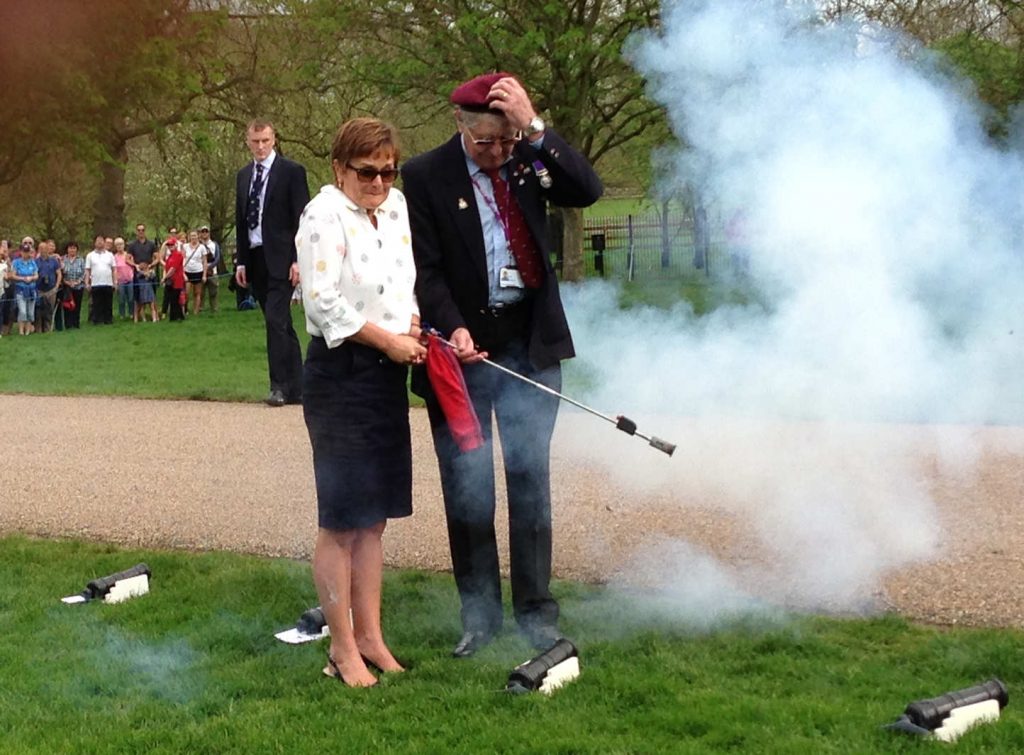
On 19th May 2018 The Long Walk was once more packed with onlookers as Prince Harry and Meghan Markle came by in a horse and carriage on their wedding day.

With close to 100,000 spectators in this part of Windsor alone, this was until then almost certainly the largest crowd ever to gather on the Long Walk. However in 2022 following the funeral of Her Majesty Queen Elizabeth II a crowd that appeared to surpass even that figure lined the walk as her Majesty’s Coffin was brought to Windsor to be finally laid to rest.
In 2023 Parallel Windsor was held on the Long Walk. This was a glorious festival of inclusivity where people of all abilities took part in all manner of challenges and events.

Windsor Great Park
Once you reach the top of the Long Walk you are in Windsor Great Park which comprises 5,000 acres of the Surrey and Berkshire countryside. Once a mighty Norman hunting forest, Windsor Park used to stretch for another 20 miles Southwest. The now much smaller, but still enormous, park, is managed by the Crown Estate and comprises formal avenues, gardens, woodland, open grassland and a Deer Park.
With the lake at Virginia Water, a great deer park, Roman ruins a chinese pagoda, ancient Oak trees, Polo Fields, Royal Lodges, A secret village and even a North American Totem pole, the remaining park provides much for 2 million visitors to enjoy each year for free.
Wildlife and Habitat
The Park includes many areas of natural and managed habitats which are home to a wide range of wildlife and plants.
Trees and Woodland

Trees are a naturally important part of Windsor Great Park. The park belongs to the Royal Family and many of the gifts of trees that they have received over the centuries have ended up here in Windsor. These days botanists come from all over the world especially to see the National Dwarf Conifer Collection at Windsor Great Park.
One of the most recognised features of the The Great Park are its magnificent ancient oak trees. Many of which started their life back in the reign of Queen Elizabeth I who issued a command for establishing oak plantations in the Park through acorn sowing. This was to replenish the stock of great oaks which had been felled for use in ship building. Some of the trees dating back to Tudor times have a girth of over ten metres.
Myths and Legends
Herne the Hunter
Where to go in Windsor Great Park
The Park comprises many popular areas open to the public including:
- Savill Garden
- Valley Gardens (seasonal highlights – spring blooms, daffodil valley)
- The Heather Garden
- Virginia Water
- The Deer Park
- The Long Walk
- The Copper Horse
- Snow Hill
- Smiths’ Lawn, Guards Polo Club
- The Totem Pole
- The Village
What to do in Windsor Great Park
- Walking and running (Windsor Half Marathon, She Runs and other organised runs)
- Dog walking
- Cycling and rollerblading
- Fishing
- Horse riding
- Polo
- Flying model aircraft
- Picnics
- For families (play parks, events)
Monuments and Statutes
- The Obelisk
- The Copper Horse
- The Totem Pole
- Queen Elizabeth Statue
Visiting Windsor Great Park
- Parking
- Opening times
- Eating (The Savill Building, Windsor Great Park Post Office and Village Store, Kiosks on Obelisk Lawn, Blacknest Gate, the Totem Pole (weekends) and Virginia Water car park (all year)).
Savill Garden is found on the south eastern boundary of the park and contains a beautifully maintained garden of rhododendrons, azaleas, trees, and conifers with a small lake and a hothouse. Savill garden was created in the first half of the 20th Century. This is the only part of Windsor Great Park that visitors must pay admission to enter.
On the eastern edge of the park is an earthwork feature referred to as the ‘Park Pale‘ on the Ordnance Survey map. A pale is usually a wooden stake fence, often associated with deer hunting and this is true in the case of Windsor Great Park.
The deer park sits between Windsor and the Great Park village. In the rutting season the calls of the stags echo across the local countryside. Other surprising calls you might hear include the squaking of parakeets. A resident population of several hundred green parakeets has been living in the park since the late 1990s. At dusk, the beech trees near Saville gardens are a good place to look for them.
Within the deer park at the top of snow hill sits the statue of King George III (yup, the mad one) who sits dressed up as a Roman Emperor on top of his horse and points off towards Slough. An inscription in Latin describes him as ‘Pater Optimo’ which I believe translates as ‘Big Daddy’.
The roman ruins are right at the other end of the park, closer to Virginia Water were transported from the site of Leptis Magna (near modern-day Tripoli) to the park back in 1818. They were rebuilt with more thought to asthetics than vericimilitude and so are a real curiousity to modern eyes.
The Totem Pole in Windsor Park
This was a gift from native peoples from the northern part of Vancouver Island in British Columbia, Canada. It was carved from Western Red Cedar and erected in 1958. As you can see from the closeup the totem pole is weathering nicely.
Smiths Lawn
In the very centre of the park is a huge flat expanse of beautifully manicured lawn where the Guards Polo team have their headquarters. During the summer there is a regular programme of fixtures leading up to The Cartier Queen’s Cup Final which has been a regular event for over 60 years.
Valley Gardens
The Valley Gardens are a real treasure. A series of steep sided valleys and ridges splayed out like the fingers on a hand lead down toward Virginia Water from the edge of Smith’s Lawn. The planting is bold with Dogwoods, Witch-hazels, Azaleas, and huge Magnolias as well as a world class display of Narcissus bulbs that erupt into flower each spring creating a yellow carpet flowing down the hillside.
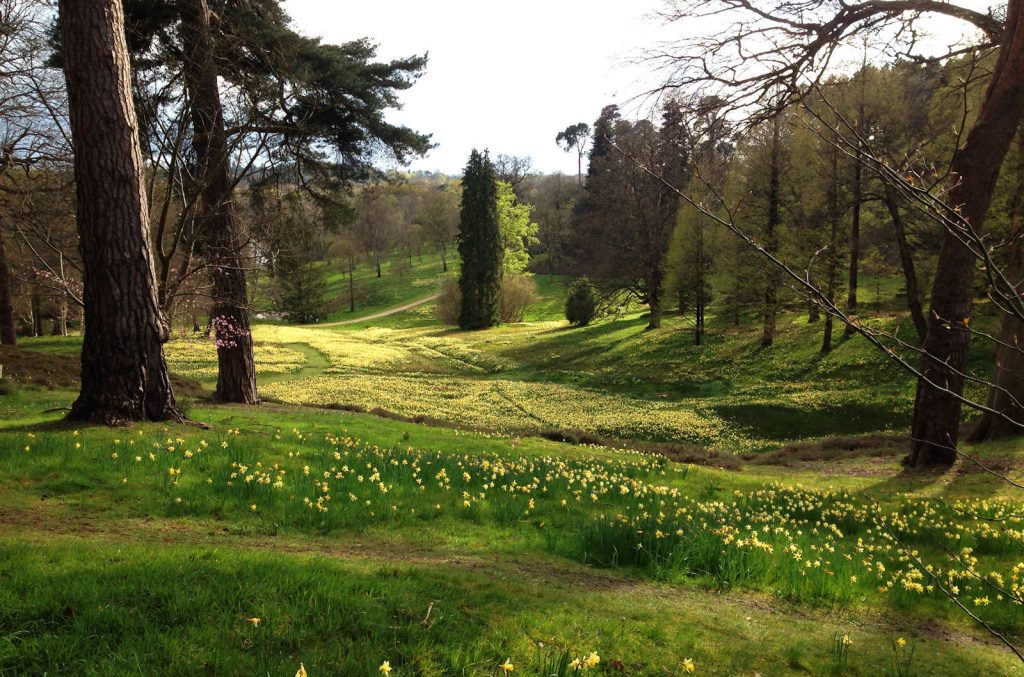
The Great Park Village is definitely worth a visit. It was built in the centre of the Great Park in the 1930s, to provide homes for people who work on the Royal estate. It is a beautiful place, best appreciated on foot or bicycle.